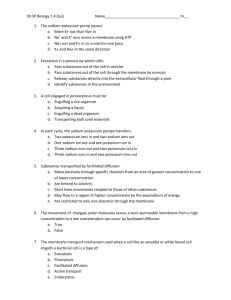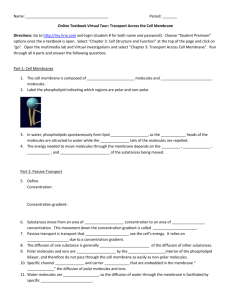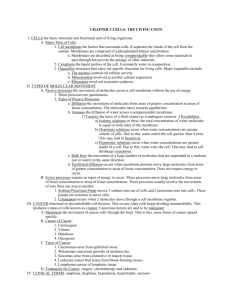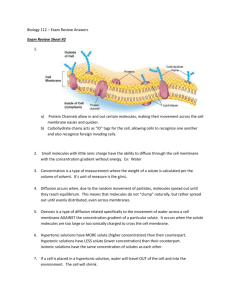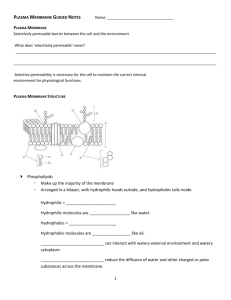Chapter 3 and 4
advertisement
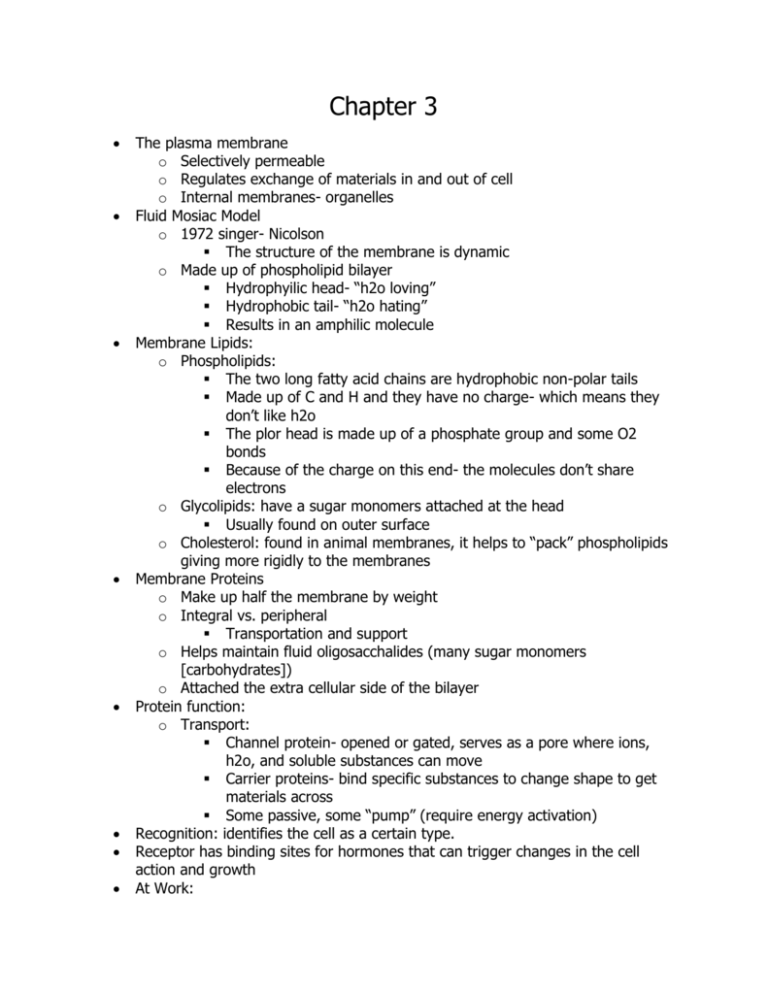
Chapter 3 The plasma membrane o Selectively permeable o Regulates exchange of materials in and out of cell o Internal membranes- organelles Fluid Mosiac Model o 1972 singer- Nicolson The structure of the membrane is dynamic o Made up of phospholipid bilayer Hydrophyilic head- “h2o loving” Hydrophobic tail- “h2o hating” Results in an amphilic molecule Membrane Lipids: o Phospholipids: The two long fatty acid chains are hydrophobic non-polar tails Made up of C and H and they have no charge- which means they don’t like h2o The plor head is made up of a phosphate group and some O2 bonds Because of the charge on this end- the molecules don’t share electrons o Glycolipids: have a sugar monomers attached at the head Usually found on outer surface o Cholesterol: found in animal membranes, it helps to “pack” phospholipids giving more rigidly to the membranes Membrane Proteins o Make up half the membrane by weight o Integral vs. peripheral Transportation and support o Helps maintain fluid oligosacchalides (many sugar monomers [carbohydrates]) o Attached the extra cellular side of the bilayer Protein function: o Transport: Channel protein- opened or gated, serves as a pore where ions, h2o, and soluble substances can move Carrier proteins- bind specific substances to change shape to get materials across Some passive, some “pump” (require energy activation) Recognition: identifies the cell as a certain type. Receptor has binding sites for hormones that can trigger changes in the cell action and growth At Work: o Uniport- one molecule is transported o Co- transported- two molecules transported Symport: 2 molecules transported in same directions Antiport: 2 molecules transported in different directions Solution: homognous mixture of 2 or more substances Solute: substance that is dissolved in a solution (usually solid) Solvent: dissolving agent, usually a liquid (h2o- universal solvent) Diffusion: o Occurs high to low concentration o Gradients in pressure temp and electron charge can also affect movement Simple Diffusion: o Diffusion of like molecules or ions down concentration gradient Substances diffuse and independent of each other (dye in water) Dynamic equilibrium: no gradients- no net movement Rate dependent on concentration temp (higher= faster) and molecules size Smaller=faster Bulk flow: o Tendency of different substances in fluid to move together in the same direction due to a pressure gradient (as seen in animal circulatory system) o Shrinks the distance that molecules travel; enhancing diffusion rates Osmosis: o The passive transport of water across a differentially permeable membrane o Response to concentration or pressure gradient Tonicity- ton of cell o Is the ability of a solution to change the shape or “tone” of cells by alternating their internal water volume 3 conditions: o Isotonic: no net movement of water relative solute concentrations are equal o Hypotonic: cells swell, solute concentration of fluid lower than that of cell o Hypertonic: cell shrivel (crenate) solute concentration fo fluid higher than that of cells Movement across membrane: o Simple diffusion: small molecules, O2, CO2, and “h2o” can cross lipid bilayer unaided o Facilitated diffusion: move larger molecules, like glucose, h2o (with aquaporis) and charged ions, like Na+, Ca+, and h2o with aid of a transport protein (passive, no need for ATP, need carrier) Active Transport: o Similar to facilitated, but not limited by concentration gradients o Carrier proteins work as “rumps” to work against gradient o ATP required o Is independent on the presence and activities of membrane proteins o Shows specify (only a certain molecule or group of molecules moved across membranes by a given active transport) o Na-K ATPase pump: (sodium- potassium pump) Uses the energy from the hydrolysis of ATP Actively transport 3 Na+ ions out the cell For each 2K+ ions pumped into the cell Helps with the resting potential and osmosis balance Vesicular Transport: o Small sacs made of membranes can transport and store substances within cytoplasm Exocytosis: move substances “out of cell” (require energy) cytoplasm and into the extracellular space Endocytosis: “into the cell” o Infolded into plasma membranes o Form vesicle and move to cytoplasm part then digest Phagocytosis: “cell eating” o Cytoplamsic extensions envelope large particles o This phagosome fuses with lysosome for digestion o Examples: Macrophages White blood cells “eat” intrudes such as bacteria Pinocytosis: “cell drinking” taking in liquids o Liquid first becomes bound or absorbed on the cell membrane o It invaginates (form a pocket) and pinches off

